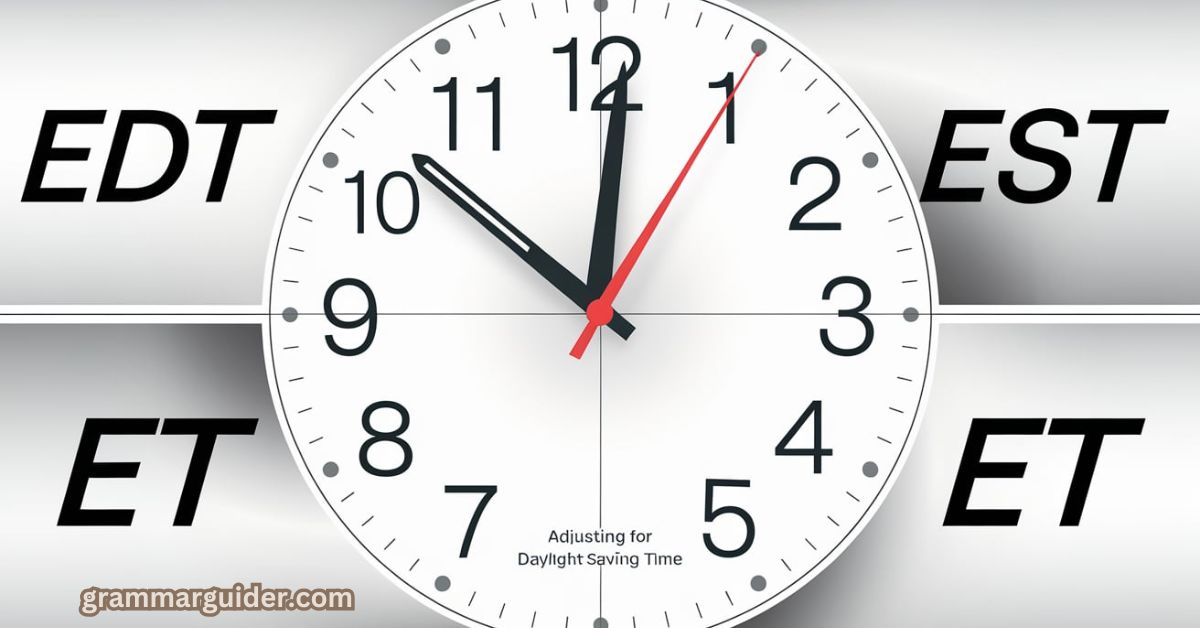When you look at the time on your phone or computer, you might notice various time zone abbreviations like Est vs Edt and ET. These terms are frequently used in schedules, emails, and global communications. However, the differences between them can be confusing, especially for people who aren’t familiar with how time zones work.
In this article, we’ll break down Est vs Edt, and ET, and explore what they mean, how they differ, and when you should use each one.
What is EDT?
EDT stands for Eastern Daylight Time. It’s the time used in parts of the Eastern Time Zone (ET) when Daylight Saving Time (DST) is in effect. DST typically runs from the second Sunday in March until the first Sunday in November. During this period, clocks are set one hour ahead of Standard Time.
For example, let’s say it’s 12:00 PM EST (noon) on the second Sunday in November. When DST kicks in, that same moment will be 1:00 PM EDT.
The purpose of EDT is to make better use of daylight during the longer days of spring and summer, saving energy and providing more daylight hours in the evening.
Scenario: Email Example for EDT
Let’s say you are scheduling a virtual meeting and need to clarify the time for someone in another country. Here’s how you might write the email:
Subject: Virtual Meeting Time – April 15, 2025
Hi Sarah,
I hope you’re doing well!
Just a quick note to confirm that our meeting on April 15, 2025, will be scheduled for 3:00 PM EDT. Please note that this time is based on Eastern Daylight Time, as we’re currently observing Daylight Saving Time here in the US.
Looking forward to seeing you then!
Best regards,
John
Here, John uses EDT to ensure that Sarah knows the meeting time is during the Daylight Saving Time period.
What is EST?
On the other hand, EST stands for Eastern Standard Time, which is the time used in the Eastern Time Zone when Daylight Saving Time is not in effect, typically during the fall and winter months. EST is 5 hours behind Coordinated Universal Time (UTC-5), while EDT is 4 hours behind UTC (UTC-4).
For example, when the clocks fall back in November, the time shifts from EDT to EST. This is why it’s crucial to distinguish between the two when scheduling or referring to times across different periods of the year.
Scenario: Email Example for EST
Here’s an example email for scheduling a meeting in EST:
Subject: Confirmation of Meeting Time – December 20, 2025
Hi Mark,
I hope you’re doing well. I just wanted to confirm that our meeting on December 20, 2025, will take place at 10:00 AM EST. Please be aware that this time is based on Eastern Standard Time, as we’re outside of Daylight Saving Time at this point in the year.
If you need to adjust for your time zone, just let me know!
Best regards,
Anna
In this case, EST is used because it’s the winter season, and Daylight Saving Time has ended.
What is ET?
The abbreviation ET stands for Eastern Time and is often used as a general reference to either Eastern Standard Time (EST) or Eastern Daylight Time (EDT), depending on the time of year.
Essentially, ET is a flexible term used when it’s unclear whether EST or EDT is being observed. This is especially useful when you don’t need to specify exactly which part of the Eastern Time Zone is being used, or if you’re referencing time in a more general sense.
When you see ET, it’s safe to assume it’s referencing either EST or EDT, but you may need to ask for clarification if you’re planning something time-sensitive, like a meeting across time zones.
Scenario: Email Example for ET
Consider this scenario where a company uses ET for scheduling:
Subject: Upcoming Webinar on March 25th
Hello Everyone,
I just wanted to remind you that our webinar on March 25, 2025, will begin at 1:00 PM ET. Please ensure that you’re logged in 15 minutes before the start time to test your connection.
Feel free to reach out if you have any questions!
Best,
The Webinar Team
In this case, the Webinar Team uses ET because they’re aiming for a more general time zone reference, assuming the participants will be familiar with when Daylight Saving Time starts and ends.
EDT vs EST: Key Differences
To summarize, here’s a breakdown of the key differences between EDT, EST, and ET:
| Term | Full Name | Time Difference from UTC | When Used |
|---|---|---|---|
| EDT | Eastern Daylight Time | UTC -4 hours | During Daylight Saving Time (March to November) |
| EST | Eastern Standard Time | UTC -5 hours | When Daylight Saving Time is not observed (November to March) |
| ET | Eastern Time (general) | UTC -4/UTC -5 | Used as a general reference for either EDT or EST |
Is ET and EST the Same?
The short answer is no. While ET refers to Eastern Time in general, EST is specifically the time used in the Eastern Time Zone during the non-DST months (winter months).
ET could either mean EST or EDT depending on the time of year.
Example Scenario: Confusion Over ET and EST
If you were scheduling an event with someone from across the country, the difference might matter. Here’s a situation where this confusion could arise:
Subject: Clarifying Meeting Time – March 10th
Hi Paul,
I noticed in the calendar invite for our meeting that the time is listed as 2:00 PM ET. Since it’s the start of Daylight Saving Time, I just want to clarify if you meant 2:00 PM EDT or 2:00 PM EST.
If you’re in the Eastern Time Zone, that would be 2:00 PM EDT here in New York. Let me know so I can be sure I’m ready at the correct time!
Best,
Rachel
This email highlights how ET can be ambiguous, and why it’s essential to check if EDT or EST should be used.
EDT vs EST: When to Use Each One
Here’s a quick guide to help you decide when to use EDT or EST:
- Use EDT when Daylight Saving Time is in effect (second Sunday in March to the first Sunday in November).
- Use EST when Daylight Saving Time is not in effect (first Sunday in November to the second Sunday in March).
If you’re unsure, and your audience is familiar with time zone changes, using ET is often the safest option. It’s especially useful when exact timing isn’t as important, but you still want to reference Eastern Time in general.
Conclusion
Understanding the difference between EDT, EST, and ET can be a little tricky at first, but once you get the hang of it, you’ll be able to navigate time-related communications more smoothly. Remember:
- EDT is used during Daylight Saving Time (spring and summer months).
- EST is used when Daylight Saving Time is not in effect (fall and winter months).
- ET is a general reference to Eastern Time, encompassing both EDT and EST depending on the time of year.
Next time you’re scheduling a meeting or sending an email, you’ll know exactly which time reference to use—whether it’s EDT, EST, or ET.
By understanding and properly using EDT, EST, and ET, you can avoid confusion and ensure clear communication across different time zones.

Jacob Harrison is the seasoned writer behind Grammar Insights, with over nine years of experience in the field. Passionate about language, he shares practical tips and strategies to help readers enhance their grammar and writing skills. With a friendly approach, Jacob makes learning accessible and enjoyable for everyone.

